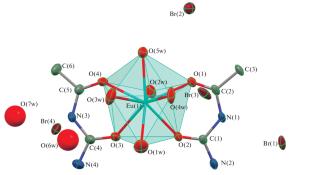稀土卤化物与乙酰脲配合物的组成和结构变化特征
IF 1.5
3区 化学
Q3 CHEMISTRY, INORGANIC & NUCLEAR
引用次数: 0
摘要
测定了稀土卤化物与乙酰脲(AcUr)、[Sm(AcUr)2(H2O)5]Cl3、[Eu(AcUr)2(H2O)5]Br3·H2O、[Ln(AcUr)2(H2O)4]Br3·H2O (Ln = Tm, Yb)和[Lu(AcUr)(H2O)6]Br3配合物的结构。对这些化合物的组成和结构以及先前报道的类似物的分析使我们能够根据元素的原子序数考虑它们变化的特征。中心原子的大小被发现是决定性的因素。本文章由计算机程序翻译,如有差异,请以英文原文为准。

Features of Changes in Composition and Structures of Rare-Earth Halide Complexes with Acethylurea
Structures of rare-earth halide complexes with acetylurea (AcUr), [Sm(AcUr)2(H2O)5]Cl3, [Eu(AcUr)2(H2O)5]Br3·H2O, [Ln(AcUr)2(H2O)4]Br3·H2O (Ln = Tm, Yb), and [Lu(AcUr)(H2O)6]Br3 were determined. Analysis of compositions and structures of these compounds along with the earlier reported analogs allowed us to consider the features of their changes depending on the atomic number of the element. The size of the central atom was found to be the decisive factor.
求助全文
通过发布文献求助,成功后即可免费获取论文全文。
去求助
来源期刊

Russian Journal of Inorganic Chemistry
化学-无机化学与核化学
CiteScore
3.10
自引率
38.10%
发文量
237
审稿时长
3 months
期刊介绍:
Russian Journal of Inorganic Chemistry is a monthly periodical that covers the following topics of research: the synthesis and properties of inorganic compounds, coordination compounds, physicochemical analysis of inorganic systems, theoretical inorganic chemistry, physical methods of investigation, chemistry of solutions, inorganic materials, and nanomaterials.
 求助内容:
求助内容: 应助结果提醒方式:
应助结果提醒方式:


